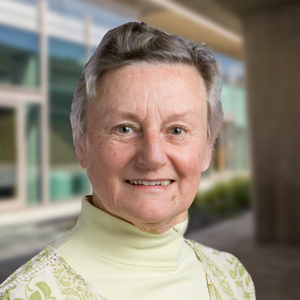Source: Interfolio F180

Jane Dyson, PhD
Research Focus
NMR is the method of choice in studying unfolded proteins, as well as proteins such as the prion protein that have highly disordered parts. Since many of the entries in the published genomes appear to code for proteins that should be intrinsically unstructured, an understanding of the nature and behavior of unfolded proteins is assuming increasing importance. Many important proteins contain disordered or dynamic regions, making structure determination by X-ray crystallography and cryo-EM difficult. Incorporation of NMR studies into the determination of the structure and function of molecular machines can define not only structures of flexible portions but can give insights into the role of molecular motions and disorder into the function of the machine. We have used such a combined approach to examine the complexes of the transcriptiion factor NF-kappaB with DNA and with its inhibitor IkappaB. These studies have led to new insights into the mechanisms by which NF-kappaB transcriptional activation is turned on and off. Another major emphasis in the lab is on the interactions of chaperones with their client proteins and co-chaperones. Again a combined approach using NMR gives new information on these dynamic and heterogeneous systems.
Links
Education
B.S. (Biochemistry), University of Sydney, 1973Ph.D. (Inorganic Chemistry), University of Sydney, 1977
D.S. (Faculty of Science), University of Sydney, 2009
Professional Experience
1977-1978 Postdoctoral Fellow, Department of Biology, Massachusetts Institute of Technology, Cambridge, MA (supervisor Paul Schimmel).1979-1984 UNESCO Lecturer, School of Chemistry, University of New South Wales Australia.
1984-1988 Research Associate, Department of Molecular Biology, The Scripps Research Institute.
1988-1992 Assistant Member, Department of Molecular Biology, The Scripps Research Institute.
1992-1997 Associate Professor, Department of Molecular Biology, The Scripps Research Institute.
1997-2001 Associate Professor with Tenure, Department of Molecular Biology, The Scripps Research Institute
2001-2013 Professor, Department of Molecular Biology, The Scripps Research Institute
2013-present Professor, Department of Integrative Structural and Computational Biology, The Scripps Research Institute
Awards & Professional Activities
1970 Royal Australian Chemical Institute Student Prize1971 Roslyn Flora Goulston Prize for Biochemistry, Faculty of Science, University of Sydney
1976 Honorary Fellowship, American Association of University Women
1977 Postdoctoral Award, Damon Runyon-Walter Winchell Cancer Fund
2010 Awarded D.Sc., Distinguished Scientist Award San Diego Section, American Chem. Soc.
2019 ISMAR Prize
2022 Member, National Academy of Sciences
Selected Publications
Wright, Peter E.; Dyson, H. J. Intrinsically disordered proteins in cellular signalling and regulation. Nature Reviews Molecular Cell Biology 2015, 16, 18-29.
[View]
Mukherjee, S. P.; Quintas, P. O.; McNulty, R.; Komives, E. A.; Dyson, H. J. Structural characterization of the ternary complex that mediates termination of NF-?B signaling by I?Ba. Proceedings of the National Academy of Sciences of the United States of America 2016, 113, 6212-6217.
[View]
Dyson, H J.; Wright, Peter E. How Does Your Protein Fold? Elucidating the Apomyoglobin Folding Pathway.. Accounts of chemical research 2017, 105-111.
[View]
Wu, H.; Hyun, J.; Martinez-Yamout, M. A.; Park, S. J.; Dyson, H. J. Characterization of an Hsp90-Independent Interaction between Co-Chaperone p23 and Transcription Factor p53. Biochemistry 2018, 57, 935-944.
[View]
Risør, Michael W.; Jansma, Ariane L.; Medici, Natasha; Thomas, Brittany; Dyson, H J.; Wright, P E. Characterization of the High-Affinity Fuzzy Complex between the Disordered Domain of the E7 Oncoprotein from High-Risk HPV and the TAZ2 Domain of CBP. 2021, 60, 3887-3898.
Singh, Amrinder; Martinez-Yamout, M A.; Wright, P E.; Dyson, H J. Structural and dynamic studies of DNA recognition by NF-?B p50 RHR homodimer using methyl NMR spectroscopy. 2022, 50, 7147-7160.

